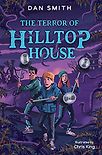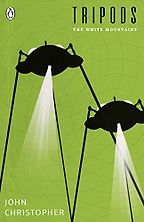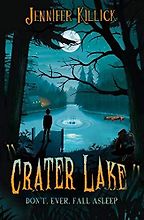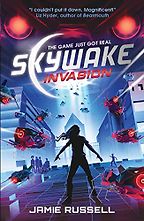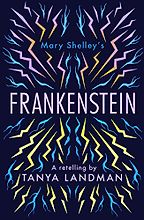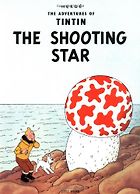I don’t remember reading much sci-fi as a child, other than Jules Verne. Can you tell me what I was missing? What do 8-12 year olds get from reading science fiction that they don’t get from other types of books?
I don’t think I read a lot of science fiction when I was younger, either. When I look at the books that are available for young readers now, I’m jealous, because we didn’t have that variety when I was growing up. For me, my love of science fiction came more from the television—I loved Doctor Who, The Tomorrow People, Planet of the Apes—and from the cinema. I think science fiction can take us away from the world we live in and transport us to somewhere completely different. Or it can twist the world we live in and make it seem more exciting or dangerous. It can make the impossible possible.
Do you think sci-fi books are more relevant than ever, with the development of AI? The idea of intelligent machines taking over seems increasingly plausible.
I suppose so. I’ve just been reading about ChatGPT, which can even write a book for you.
My colleagues have done an interview with ChatGPT, asking it to recommend the best books on artificial intelligence. It did quite a good job.
It is a little bit scary, but I think science fiction has always been relevant. When H.G. Wells and Jules Verne were writing, there were advances in technology and industry that they could write about and use to fill readers with wonder and fear. Science fiction is a huge genre, it can almost be anything. You’ve got your highbrow very sciency science fiction and you’ve got your more lowbrow—but fun—monsters and bug horror science fiction, so it’s quite a broad topic.
Some of it can very effectively get to the question of what it is to be human, if you think about being abducted by aliens or invaded by aliens.
Abduction by aliens was something that fascinated me when I was younger. One of the things I loved was going to the little library at school where they used to get a magazine called The Unexplained. It had stories about alien abductions and UFO sightings and weird stuff like that, so maybe that’s where my sci-fi love came from.
Let’s talk about your first pick of the best science fiction for 8-12 year olds, The Shooting Star, which is the 10th volume in The Adventures of Tintin comic book series. This one was published under Nazi occupation with some anti-Semitic portrayals and was revised in the 1970s.
I was aware that there is some controversy about quite a few of the Tintin books because of racial stereotyping, but I didn’t realise this was one of the books. I first read it in the late 1970s, when I was seven or eight years old and I enjoyed it for being an adventure that had this slightly weird twist to it. I travelled a lot as a child and Tintin was always a thing that I would read sitting on aeroplanes. The Shooting Star was probably the first one I read.
It begins with an end-of-the-world thing going on, there are plagues of rats and tar melting on the roads. Scientists claim that the world’s coming to an end because this meteor is going to crash into Earth, but when it does hit the Earth, it doesn’t destroy the planet, it lands out in the ocean somewhere and there’s a race to get to it. When Tintin arrives, the meteor is a sinking island with exploding mushrooms growing on it. Tintin discards an apple core and it grows into a tree, and a spider grows to become enormous. That was what interested me, the weirdness of it.
Your next recommendation is The White Mountains, which is part of The Tripods series. Am I right in thinking it is set in a post-apocalyptic future?
It begins in a version of England, where people live what is almost a medieval life, but there are artefacts left over from what we might think of as modern life. As a kid, I first became aware of it as a TV series, but I only ever saw little snippets of it. In the story, Earth has been taken over by H.G. Wells-ish ‘Tripods’, which enslave people by ‘capping’ them. When you reach the age of 14, you get taken up into one of these Tripods and they put a ‘cap’ on your head, which makes you very submissive and obey the will of the Tripods.
It’s about a boy called Will who is about to become 14 and be capped. He meets what is known as a ‘vagrant’, which is a person who has been capped and gone insane. This vagrant, called Ozymandias, turns out not to be insane at all and he tells Will that there is a place in Switzerland where people live in freedom. Will and his cousin set off on a treacherous journey to reach Switzerland and be free. I think the appeal for me is that the kids are on their own and they have to survive on the road. They have to find food and shelter, and learn who they can and can’t trust, all while evading the Tripods which are hunting them. It’s about free will, but I think as a young reader, it was the idea of these giant Tripods stomping around the Earth that excited me.
Let’s move on to your third choice, Crater Lake by Jennifer Killick. Does it have the same combination of thrills and humour as her Dread Wood series?
Yes it does. Jennifer Killick started off writing funny books, and then she published Crater Lake, which has the combination of being funny and being a bit scary, which is really hard to do. It has that sci-fi element because … have you read it?
I haven’t, but I read that it features alien wasp spores that zombify children.
Yes, Crater Lake does have freaky alien wasps and spores and mind control that turns people into bug-eyed zombies, but they’re not reanimated dead people. It’s probably more accurate to say it has an Invasion of the Body Snatchers vibe. It’s set in a residential camp and there are aliens and a huge hole in the ground and people are behaving in a strange way. Invasion of the Body Snatchers was a big inspiration for my book, The Invasion of Crooked Oak, and I enjoyed that element in Crater Lake. Jennifer Killick has been doing really well, mixing the scares and comedy. I have read the sequel, Crater Lake: Evolution, which is great, and I’ve also been reading the Dread Wood books which are tremendous fun – with a few scares to keep readers on their toes. I’ve just got the latest one, Flock Horror, and it’s on my table ready to read next.
Let’s talk about your next book of sci-fi for 8-12 year olds, Skywake Invasion, the first in the Skywake series.
This is a very different kind of sci-fi. This one is more like an action sci-fi in the vein of Starship Troopers. I should add that the film version of Starship Troopers is very fast-paced but also extremely violent, so is definitely not for children.
Skywake Invasion is about a girl called Casey who is a gamer, and plays an online game called Skywake Invasion. Casey is part of a team but because she plays online and she has a voice changer on her mike, her teammates don’t know she’s a girl. The team is invited to go to a big tournament and Casey is worried that they will all find out she’s a girl and not accept her as part of a team because of it, so she takes her brother with her to pretend he’s the player. It turns out that this tournament is actually a recruitment drive for aliens. The aliens have invented the video game to find out who the best kids are at fighting, and they’re going to abduct them all and take them away to their alien planet to use them as soldiers. Casey’s brother is abducted so she has to rescue him.
There’s loads of action and stuff going on, but at its heart, the story is about friendship and acceptance and working together. Jamie Russell, who wrote it, is obviously a gamer: he gets the whole gaming thing. It’s great fun. This book is probably for readers at the upper end of middle grade, so 10-12 year olds.
We’ve come to your final recommendation of science fiction for 8-12 year olds, a retelling of Mary Shelley’s classic novel Frankenstein. It’s published by Barrington Stoke, a publisher that specialises in books for dyslexic and reluctant readers.
I love the idea of a retelling that makes it easier to read. Frankenstein is an important book, it’s the granddaddy of science fiction horror. But it is an old book. It is quite difficult to read with modern eyes and the language can feel a bit old-fashioned. Obviously, it’s not written for young readers but everybody has heard the name Frankenstein, so I think it’s good for them to have the opportunity to read it. This book will probably also be for the older end of middle grade readers.
So not only for reluctant or dyslexic readers, this retelling will appeal to kids who are interested in the story but not quite up for reading old-fashioned language?
Yes, definitely. I think it’s great to be able to read it in an easier way. Frankenstein is interesting because it’s a story of people telling stories. It begins with an explorer meeting Victor Frankenstein, who tells his story about how he became obsessed with science, how he created this man but was ashamed of what he had done. He rejected his creation, which became angry and murdered Frankenstein’s brother. So Victor Frankenstein hunted the creation down, only for it to recount how it had educated itself and learned to be human. The creation persuades Frankenstein to make a partner for it, which Victor Frankenstein agrees to do. But in the process, Frankenstein decides he’s doing the wrong thing and destroys all his work, which enrages the monster who then kills Frankenstein’s wife and his friend. By modern standards, it’s probably quite a tame story in terms of the sci-fi horror side of it, but it’s an interesting story and it’s an important story because it’s where it all started.
Your Crooked Oak series is also an easily readable series, isn’t it? Is it important for you to make books accessible to as many readers as possible?
Yes, the Crooked Oak books are short and easily readable. I think that for a lot of kids who think reading is not for them, it’s nice to be able to pick up a short book. And it’s important for them to have a book that is easy to read where the interest level is a bit higher than the reading level. When I write a book, I just write a story because it’s the story I want to write. But with those books I do try to make them less dense and move the story on as quickly as I can. There’s a bit more of a restriction in terms of word length and word count, but they’re great fun to write. I love writing them.
Are you working on any new books for kids right now?
I have a book coming out in June called The Wall Between Us. It’s set in 1961, and it’s about two cousins, Anja and Monika, who are best friends. They live on opposite sides of the same street in Berlin but are separated when the Berlin Wall is built. It’s a story about separation, friendship, oppression, bravery, and a world where shadowy threats lurk around every corner. It’s partly told through diary entries, partly through letters, interview transcripts, secret notes, newspaper articles, all sorts of formats.
I am also working on another Crooked Oak story. The most recent one, The Terror of Hilltop House, was very much inspired by The Day of the Triffids, which is one of my favourite science fiction horror stories. The Crooked Oak story I’m working on now involves Pete, Nancy and Krish investigating a meteorite, a lead mine, and some very unpleasant creatures.
Is there anything else you want to say about sci-fi for kids?
There seems to be so much out there at the moment, but I don’t feel as if there’s a lot of science fiction. There’s a lot of fantasy, and a lot of historical stories, but I think we need some more science fiction, some creepy sci-fi. There definitely seems to be a growing appetite for it among younger readers, and if we want to keep young people reading, we have to give them the kinds of stories they want to read.
Interview by Tuva Kahrs
March 14, 2023. Updated: February 24, 2025
Five Books aims to keep its book recommendations and interviews up to date. If you are the interviewee and would like to update your choice of books (or even just what you say about them) please email us at [email protected]
Five Books interviews are expensive to produce. If you've enjoyed this interview, please support us by donating a small amount.

